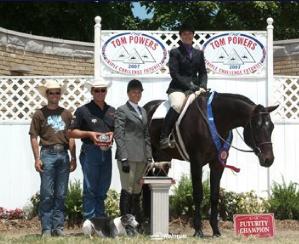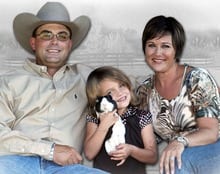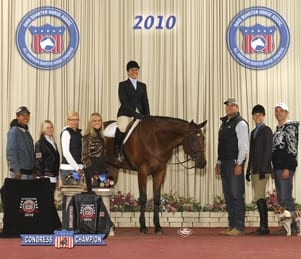According to World and Congress Hunter Under Saddle Champion trainer,
Kim Reynolds of Fairfield, Florida, in order to win at the big shows you must have a horse that has potential and talent. That being said, Reynolds has
some very helpful tips and suggestions of how to set yourself up for
success at the big shows.
At the 2010 AQHA World Championship Show, AQHA Professional Horseman Kim Reynolds and Big League Potential took home the gold trophy in Senior Hunter Under Saddle. The year before, Kim and “Bentley” were reserve world champions in the same class. Bentley and Reynolds were also back-to-back champions at the All American Quarter Horse Congress in 2009 and 2010.
Considered an expert in Hunter Under Saddle, Reynolds discusses what she does to get the judge’s attention in the arena; her opinions on the type of horses that should win in the class; and also thoughts on how judges can help improve the class.
Strong First Impression–Reynolds says that she always tries to go in first if she can with a strong and confident trot to set the pace and have her horse in the judge’s minds at the start of the class. “I want to make a strong first pass at a trot,” she told GoHorseShow. “If we are able to go in the arena and warm up a little and my horse has a stronger canter–then I start cantering and showing my horse off to the judges. I try to show the horse to the best of its ability.”
 Canter– Most Important Gait–Since this class is a preparation class for horses that move on to do the hunters, Kim says that the canter is the most important gait. “However, that doesn’t mean that your horse doesn’t need to walk or trot,” Kim stresses. “The horse needs to be strong in all gaits but I believe the canter is slightly more important because you have to have a strong canter that has cadence and pace to be able to get over the jumps effectively and meet the strides between the jumps easily.”
Canter– Most Important Gait–Since this class is a preparation class for horses that move on to do the hunters, Kim says that the canter is the most important gait. “However, that doesn’t mean that your horse doesn’t need to walk or trot,” Kim stresses. “The horse needs to be strong in all gaits but I believe the canter is slightly more important because you have to have a strong canter that has cadence and pace to be able to get over the jumps effectively and meet the strides between the jumps easily.”
Rail Placement–It is important for the judges to be able to see your horse. At the World and the Congress, they announce for people to show on the rail, but at the smaller shows, that is never stressed. “I have had clients ride on the rail, like they have been told but then the judge didn’t do their job of searching out the horses on the rail, and then, my clients asks me why I want them to show on the rail when they get covered up and don’t place well. It is all well and good to tell people to show on the rail but the judges need to do a better job of finding those horses and rewarding them. Until that happens, riders are still going to ride toward the middle to make sure they are seen.” Reynolds said she remembers that happening to Angela Gay when she showed Big League Potential. “One judge found her on the rail, but the other judges didn’t–so we really need to work more on rewarding the nice horses that are staying on the rail.”
Western Style vs Hunter Style Horses–Reynolds says that the smaller more “western style” hunter under saddle horses are a lot easier for novice riders to show because it is easier for them to keep them together and collected and have their head set more consistent and steady. The lankier, longer necked horses are more difficult for the beginners. Reynolds says that both types of horses should be able to do well in this class. “The bigger hunt seat horses that are nice movers but that cover more ground should not be hurt for having a longer stride–while at the same time, smaller horses that are very nice movers that move well through their shoulders and have a nice long stride should also not be penalized for being smaller in size. Both types of horses have a place in this class. “They don’t have to be huge, just great movers.” Reynolds mentions that the hunter under saddle breeding stallions like Allocate Your Assets, Hot Ones Only, and Iron Age have done wonders with the style and temperament of the hunter under saddle horse, and she believes the class is headed in the right direction.
 Stay Consistent–While a horse that is a great mover is a must, Reynolds says that World and Congress Champion, Big League Potential wasn’t the best trotter when she had him but that he always gave his all and he was very consistent. “Every time someone looked at him, he looked exactly the same. His top line and expression was always the same, and he looked happy doing his job.”
Stay Consistent–While a horse that is a great mover is a must, Reynolds says that World and Congress Champion, Big League Potential wasn’t the best trotter when she had him but that he always gave his all and he was very consistent. “Every time someone looked at him, he looked exactly the same. His top line and expression was always the same, and he looked happy doing his job.”
Mix it Up–Reynolds would like the judges to mix up the gaits more, especially for the older hunt seat horses. “I would like to see them call a hand gallop and a sitting trot in the Hunter Under Saddle,” she strongly emphasizes. “Anything that can help the horses stay fresh.”
Rail Etiquette–Reynolds says that a rider must be respectful of their competition and not cut them off or cause a wreck. “They must be able to find their spots and always look ahead to see where would be the best to show off their horse–whether it would be off or on the rail. “You need to stay away from the crowd and try to think ahead and find the best spots. Also, if there is a horse in the arena that you know is a better trotter than your horse–try to be on the opposite side of the arena from them.” Kim adds, “I’m a very competitive person and if I end up covering up my best friend in the class because I have a better spot then, that is her problem. It is their job to ride and find the best spots for their horse. If, they are unable to show their horse off well–then they didn’t do their job and wasn’t wise in the choices they made in the arena.”
 Headsets–-Reynolds says that the rider’s reins don’t need to be bouncing and the horses head set shouldn’t be too high or too low. The horses also shouldn’t look intimidated, over bridled or nosed out and evasive either. “I don’t mind a horse that may be slightly lower or slightly higher than the standard as long as the horse doesn’t look intimidated and it looks natural on that horse. Sometimes it may be more abusive to try and get a horse to keep his head up than to let the horse leave it a little bit lower if it seems comfortable for that horse.”
Headsets–-Reynolds says that the rider’s reins don’t need to be bouncing and the horses head set shouldn’t be too high or too low. The horses also shouldn’t look intimidated, over bridled or nosed out and evasive either. “I don’t mind a horse that may be slightly lower or slightly higher than the standard as long as the horse doesn’t look intimidated and it looks natural on that horse. Sometimes it may be more abusive to try and get a horse to keep his head up than to let the horse leave it a little bit lower if it seems comfortable for that horse.”
Equitation–While the judge is evaluating the horse in this class, it is important for riders to know their diagonals and present a strong body position and leg to show their horse off. Some riders have their hands too far apart, show with “puppy dog” hands, have a loose body position and flop everywhere, and may have their legs loose and too far forward. If the rider is not a strong and confident rider, the horse will probably not move as well and their headset will be all over the place. It is important to work on your riding skills in this class.
Concluding thoughts–Reynolds says that she doesn’t change her routine at the big shows. She likes to de-stress as much as possible by riding with her iPod and listening to music when she rides. “I also don’t worry about what other people are riding and what they are doing. I try to stay with my game plan and not change anything that has worked in the past. Exhibitors need to be able to tune the world out and focus on only them and their horse. They need to trust their horse and realize that their horse isn’t going to be perfect but try to show what they have at that particular moment to the best of their ability.”








